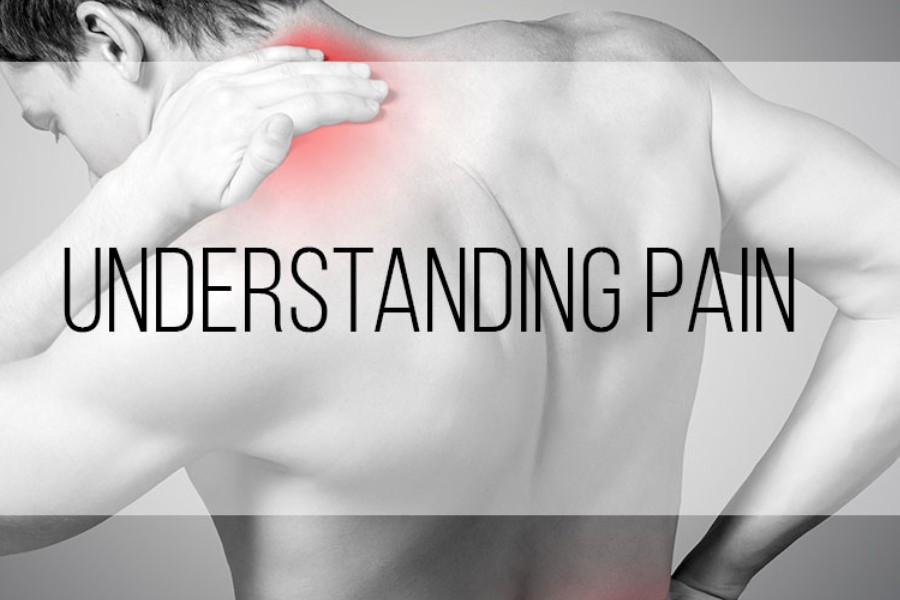
Pain is a sensation interpreted by our central nervous system (CNS) after a mechanical, thermal, or chemical signal is first converted to an electrical (nerve) impulse. It is a perception developed through evolution, much like smell or taste in its physiological properties and it carries an important function in the body to keep us aware of damage and threat of damage to our cells, tissues, and organs. Pain is a protective indicator telling us to take our hand off a hot stove and prevent running on a sprained ankle, but there are times when the CNS gets it wrong. It is commonly categorized in two groups, acute and chronic. Acute pain is somewhat well understood and typically occurs when a tissue is acutely damaged, as in an ankle sprain or cutting oneself. Chronic pain, however, is still somewhat a mystery.
A pain signal is transmitted to the brain in a similar manner as touch or sensation of pressure and temperature. A receptor first picks up the initial signal at the site (touching a hot stove with a finger) which it then converts and propagates into the spinal cord. The spinal cord then conveys the nerve signal upward toward the brainstem and through many connections in the lower brain centers finally into the cortex of the brain where conscious interpretations are made. As you may notice, there is quite a lot going on. Now, in some instances such as an acute ankle sprain this process seems simple; a tissue is damaged and we sense pain. However, in many chronic issues the lines are not as well defined.
In a recent collection of studies, it has been found that there is a great deal of disconnection between MRI findings and actual symptoms of chronic conditions such as rotator cuff tears (RCT), low back pain (LBP), neck pain, and others. In 50-80-year-old, ASYMPTOMATIC adults, the prevalence of RTC was found to be 20-50% and the number for intervertebral disc protrusions was 30-50% in a similar population. Furthermore, 70-90% of asymptomatic population exhibited cervical disc bulging upon imaging. If up to 90% of ASYMPTOMATIC population has an injury as shown by MRI, why does only a fraction of the population develop symptoms? Current theories suggest that there is a complex interconnection between threat experiences reported to the CNS consciously or subconsciously and the memory centers of the brain. Just as experiences with math problems alter the brain construction, experiences with pain or the threat of damage can alter and hyperactivate the brain and propagation pathways of pain signals (what we call central- and peripheral sensitization, respectively). Think about the classic psychology experiment carried out by Pavlov and his dogs. The dogs were trained to associate food to the ringing of a bell and as a response they started to salivate. After “enough” repetition, the dogs started to salivate without the sight of food. Think of the food as tissue damage and salivation as the pain response. Anxiety of potential threat associated with movements can alter the biophysiological “highways” of pain transmission, thus leading to experiences of pain even in the absence of actual damage in tissues. In common terms, one becomes hyper-sensitive to pain signals.
Now, don’t think that the article is written to let you know that the “pain is in your head” or “the pain is not real”. The perception of pain is always physiological and real, but in many chronic cases it doesn’t reflect tissue damage and threat of damage accurately. Fortunately, just as Pavlov’s dogs eventually regressed back to normal with their salivary response, we can most often desensitize our altered chronic pain pathways by appropriate therapy. Consider chronic low back pain as an example; you hurt your back while picking up something heavy years ago, and through sensitization and heightened threat perception just bending forward now hurts. We know that there is most likely no tissue damage occurring in the back but the pain is still there. What can you do? Movement therapy is a well-studied and effective way of gradually resetting the nervous system into “letting go” of its beliefs of threat. By completing pain free motions through manual therapy and resistance training the CNS most often realizes that it’s been over protective and will allow for improvements in movement control and overall quality of life. Don’t let persistent, chronic pain dictate your life choices but seek for professional help for guidance through the “reset” process. Contact us at Naples Personal Training to start re-educating your body to accept movement and resistance and start getting relief for chronic pain and get active again!




